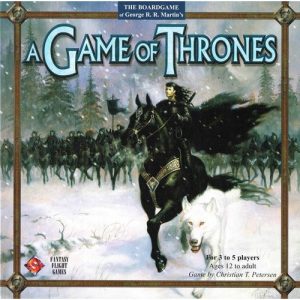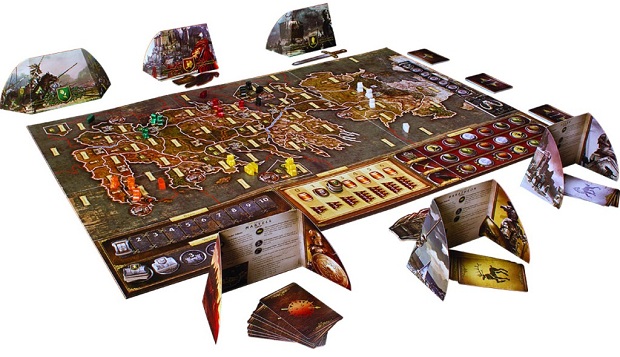Game of Thrones, and Getting On Board With Tie-Ins in Games
The first time I attempted Fantasy Flight’s table top Game of Thrones game, there was something of a hurdle. Every player – every potential player – at the party was a bit too drunk to sort strategy cards or distribute cardboard tokens, and the War of Five Kings ended early with a battle cry of “Let’s just get pizza!” It took another month before I found a group to try again, and much like A Song of Ice and Fire, it took a little patience to collect huge rewards.
When the Game of Thrones game was first released, the fourth book of the series was yet to hit shelves, never mind the pipe dream of a movie or TV show. It’s since seen a few expansions and a second edition that updated and streamlined the rules. The core of the game is the same, though, a sprawling strategy/territory simulator with a bit of an entry barrier but an intuitive mode of play. The particularly interesting thing about it, and the reason I think it deserves a write up ten years after the fact, is that few tie-in games simulate the experience of their properties as well as this one.
Pretty much every gamer is familiar with the segregation of story and game-play, like RTS cut scenes where a generic disposable mook-unit hacks down enemies by the dozen. This is particularly rife with games designed to cash in on saleable properties, or even less cynical attempts to turn a beloved book or movie into an enjoyable game. Arkham Horror, great game that it is, illustrates this; the game is rife with eldritch abominations and starts the clock of apocalypse from turn one, but it’s hard to get that really spot-on Lovecraft feel when shoggoths and night-gaunts are statted out and most turns consist of monster-hunting and clue-chasing more reminiscent of an episode of Supernatural. I played one memorable session in which the difference-maker was a crazed professor riding a police paddy-wagon around the town square, hacking down tentacled monstrosities with a magic sword; amazing and well worth the hours I spent on it, but not exactly the stuff of which squamous nightmares are made.
A better take is Shadows Over Camelot, the classic Arthurian mostly-co-op game that fields a swath of questing knights against all the travails of Arthur’s Britain. Of course, the real keystone of the game is the traitor; one of the knights is in league with darkness, plotting the inevitable fall of Camelot. It’s not exactly spot-on recreation of the Matter of Britain (which would, of course, make for a boring and predictable game), but it gets the idea of what makes the whole Arthurian thing so appealing. You’ve got knights in shining armor, doing heroic deeds, but also bound by the rules of the game to do something villainous every turn as well, because they are mortal and fallible; and all the while, there’s a worm eating at the kingdom’s heart. That’s pretty much the story, and playing Shadows presses a lot of the same buttons that a read-through of The Once and Future King does, beyond just name-checking Gawaine and Lancelot.
Game of Thrones board game
 But to bring it back around, the Game of Thrones game is the gold standard for recreating the experience of its root property. The play style – and it is, essentially, a complicated sort of Risk – rewards a mix of long-term planning and sudden, subtle switches. Your actions are committed in advance but concealed from the other players, which outright encourages you to conclude non-binding agreements with your friends and then go about your business in the sketchiest way imaginable. The decisions you make in the opening turn can doom you, but never ensure victory – unless, that is, you’re the only person not to fuck up. Quite feasible.
But to bring it back around, the Game of Thrones game is the gold standard for recreating the experience of its root property. The play style – and it is, essentially, a complicated sort of Risk – rewards a mix of long-term planning and sudden, subtle switches. Your actions are committed in advance but concealed from the other players, which outright encourages you to conclude non-binding agreements with your friends and then go about your business in the sketchiest way imaginable. The decisions you make in the opening turn can doom you, but never ensure victory – unless, that is, you’re the only person not to fuck up. Quite feasible.
And the stuff that’s outright plucked from George R.R. Martin’s pages is pretty spot-on without being just a book simulator. The Iron Throne, for instance, is a resource that one player can possess; like in the books, the reigning monarch has an advantage in any contest (a tie-breaking mechanic) but not nearly enough to ensure victory in all situations. And the support of the Citadel gives you Westeros’s best information network (a raven token letting you modify the order of your actions), but it won’t save you from making the wrong decisions with that information. This goes right on down to the Houses, which are encouraged by starting placement & resources to undertake a certain mode of play – the Greyjoys can get off to a great start ravaging the coasts, the Lannisters can replace their troops as fast as they lose them, and the Starks, unlike poor Ned & his brood, would do well to just build up their strength & wait.
But the mechanics aren’t overtly rail-roady. Your House cards (personalities from the books, cause, y’know, you’ve got to have them) give you a fairly broad spread of cool tricks that surely support certain modes of play but also give you an unexpected out. And there’s a bit of a meta-strategy when you’re playing with other fans of ASOIAF, who might well be expecting a certain proscribed set of events. “I know that Baratheon attack is coming,” they might think; “It’s the Baratheons, that’s what they do, that’s what they’re for. Can’t commit because they’re going to hit me any turn now.” It’s a weird sort of experience that’s hard to recreate in tie-in games, but Fantasy Flight handled it adeptly.
So if you haven’t tried this one out yet, do so; it’s worth the effort to punch out and count all those obnoxious little cardboard tokens. And I’ll close by opening the floor to questions – what are some tie-in games that you think capture the feel and appeal of their parent properties? What are some that absolutely don’t, and are they fun anyway? And what book or show or movie – or, for that matter, game of a different stripe – do you think needs to be put in a box and delivered to your game room, ready to capture that same feeling?







Other tie-in games: While BSG did a good implementation of the show and then the various transitions of the series through expansions; it ends up getting bogged down in too many rules/complications. However BSG Express (http://boardgamegeek.com/boardgame/111124/bsg-express) really boils the rules down while keeping the tension around the end of the human species. Worth a look.